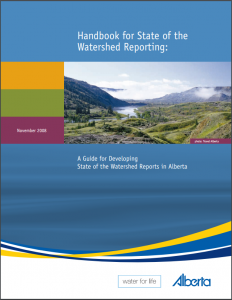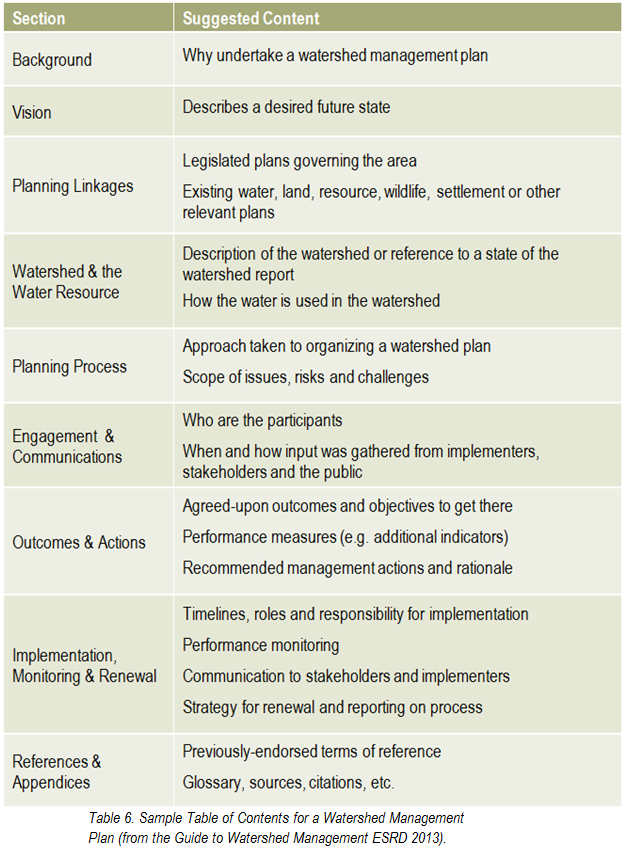- About ALMS
- Programs
- News and Events
- AGM 2023-2024
- In-Lake Treatment Seminar
- Lake Stewardship Community of Practice
- Newsletter
- Recreational Water (Beach) Monitoring Webinar
- Volunteer of the Year
- Workshops
- 2024 Annual Conference in Hinton
- 2023 Annual Conference
- 2022 Annual Workshop
- 2021 Webinar Series
- 2020 Webinar Series
- 2019 Annual Workshop
- 2018 Lake Days
- 2017 New Perspectives
- 2016 NALMS: Science to Stewardship: Balancing Economic Growth and Lake Sustainability
- 2015 Innovation. Collaboration. Adaptation
- 2014 Exploring the Past, Planning for the Future
- 2013 Lake Watershed Plans
- 2012 Lakeland
- 2011 Urban Lakes
- 2010 Stewardship
- Resources
- How You Can Help
- Outreach
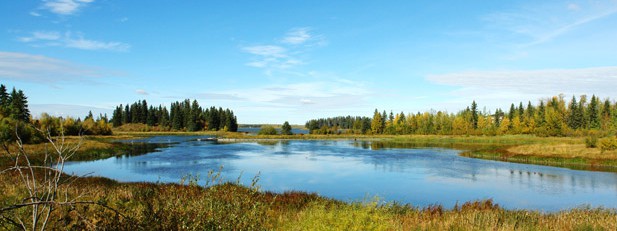
Healthy Lakes for Alberta’s Future
Wakes, Waves, and Shoreline Erosion Webinar
Research on Lakes of the Carvel Pitted Delta!

Check out the latest research published in the Journal of Water on the lakes of the Carvel Pitted Delta project!
https://www.mdpi.com/2073-4441/17/3/440

2024 Supporters



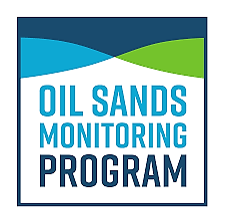
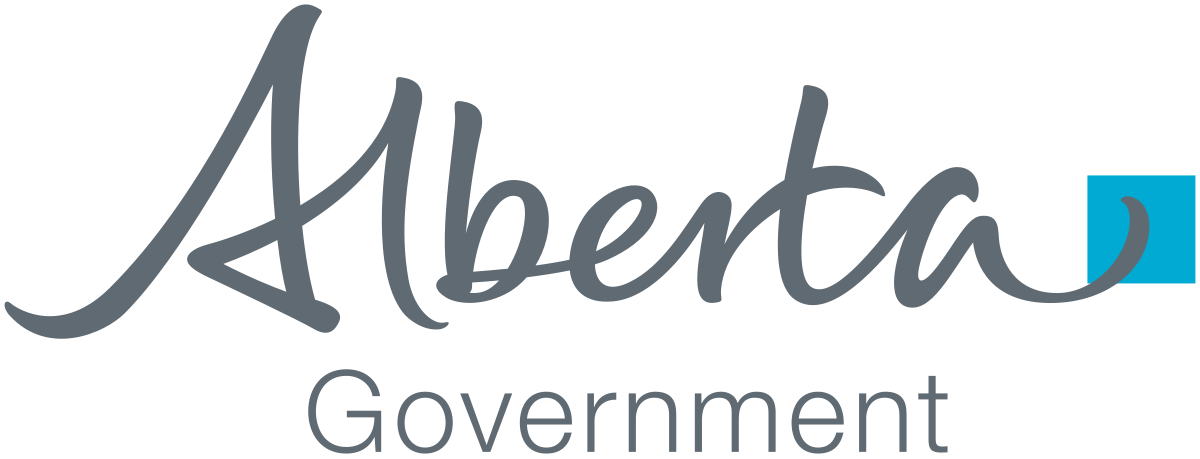

Step 8: Identify outcomes, objectives, and indicators

Before identifying outcomes, objectives, and indicators, it helps to refine the plan’s vision statement. A vision should be inspirational, but also achievable. See the Sylvan Lake Case Study for an example of creating an effective vision statement.
For more information on selecting and evaluating indicators, see Table 3 (pages 24-25 in the Workbook), or consult the Guide to Reporting on Common Indicators Used in State of the Watershed Reports.
Step 12: Establish an implementation committee
 The members of the steering committee will continue to play a strong role in facilitating and tracking implementation actions. This includes any actions they were responsible for, as well as tracking other committees and sector’s actions and progress made towards achieving the plan’s outcomes. Ongoing communication is essential to successful implementation and achieving outcomes, therefore a regular reporting mechanism could be set up in order to provide regular evaluation of the plan.
The members of the steering committee will continue to play a strong role in facilitating and tracking implementation actions. This includes any actions they were responsible for, as well as tracking other committees and sector’s actions and progress made towards achieving the plan’s outcomes. Ongoing communication is essential to successful implementation and achieving outcomes, therefore a regular reporting mechanism could be set up in order to provide regular evaluation of the plan.
Understand
Step 1: Prepare a State of the Watershed Report
A State of the Watershed (SoW) report is a comprehensive document that helps to identify key issues to be addressed in order to protect or restore lake health. It summarizes ecological, social, economic and demographic factors influencing a lake, and is specific to the characteristics of each lake’s watershed. SoW reports also identify baseline conditions from which to measure future change and progress. Traditionally, SoW reports include technical numerical data, but any type of data can be used. For example, Métis and First Nations Traditional Environmental Knowledge is a very valuable resource for understanding lake management. Other items typically included in SoW reports are:
- A map of the watershed and its major land-uses and cover types
- Key indicators of watershed health (e.g. water quality, landscape indicators, biological indicators)
- Water budgets and historical water level data
- Nutrient budgets (e.g. phosphorus)
- Sediment analysis
- Social or demographic trends
Useful Links
State of the Watershed Reporting Handbook: A Guide for Developing State of the Watershed Reports in Alberta (Alberta Environment, 2008)
Guide to Reporting on Common Indicators in State of the Watershed Reports (Alberta Environment and Sustainable Resource Development, 2012)
Examples of Completed State of the Watershed Reports in Alberta (ALMS)
Step 5: Identify priorities and the scope and scale of planning activities
Some issues or concerns may have already been identified in the State of the Watershed report (Step 1), but it is also necessary to involve all of the stakeholders in selecting which issues and opportunities to focus on. Involve the advisory group members (which has broad stakeholder representation), by having them identify and list all concerns and opportunities regarding the watershed’s natural resources and economic trends that have an impact on quality or use. Another way to identify issues is through a watershed community survey. The NALMS publication, Managing Lakes and Reservoirs, provides information on conducting effective community surveys. Lac La Nonne provides a good example of this process in Alberta, and it is included on the Case Studies page. 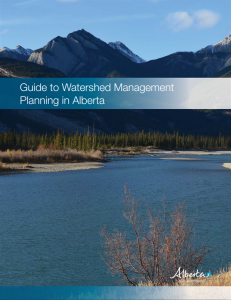
Online or mail-in surveys should be supplemented by phone interviews to ensure that the results are representative of the public opinion. Opinion surveying is a complex science, and provincial government agencies or universities have sometimes provided assistance to community groups in the past. Once surveying has been completed, the stakeholder advisory group should be asked to assess and prioritize the identified issues from the State of the Watershed and from the completed surveys. Use criteria such as:
- Is the group able to change the situation?
- Is the group motivated enough to address the concerns?
- Will the costs outweigh the benefits?
- Is it going to improve or maintain the ecological health of the lake and its watershed?
The Guide to Watershed Management Planning in Alberta outlines several tools to help select the priority issues to be addressed in the watershed management plan. Don’t try to tackle all of the concerns at one time! A watershed management plan is a continuous cycle, so choose to address priority problems over time or focus on specific watershed areas initially. Allow for regular re-confirmation of priorities before starting new projects.
Step 15: Report on implementation and outcomes
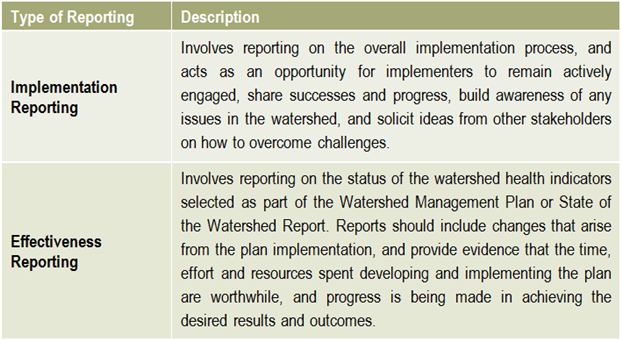 Reporting is an essential component of any watershed management planning and implementation process. There are two main types of reporting that should be shared with stakeholders on a regular basis: implementation reporting & effectiveness reporting.
Reporting is an essential component of any watershed management planning and implementation process. There are two main types of reporting that should be shared with stakeholders on a regular basis: implementation reporting & effectiveness reporting.
Regular reporting throughout the implementation of the watershed management plan process is a very important step for morale and overall success of the plan. Highlighting the successes of the plan helps inspire people to continue working towards the desired outcomes, and also emphasizes the transparency of the whole process, leading to greater trust in the process itself and confidence in the outcomes.
More information on reporting can be found in the Guide to Watershed Management Planning in Alberta (pages 39-40).
Step 9: Develop, evaluate and select preferred management actions
 There is no limit to the number or types of lake management actions, but they typically fall into the categories on the right.
There is no limit to the number or types of lake management actions, but they typically fall into the categories on the right.
Be careful of “quick-fix” technologies! Always ask about well-documented examples of the use of such technology for the specific type of lake management problem in question. These technologies may not be as practical as they seem, and some aren’t even legally allowed in Alberta. A summary report developed by the Alberta Government in 2012 lists some benefits and drawbacks of commonly used in-lake treatments and techniques to control nuisance blue-green algae blooms at Pigeon Lake.
The NALMS publication Managing Lakes and Reservoirs, provides information on guiding lake management groups through this step, and their website also lists a directory of Certified Lake Professionals with demonstrated experience in this field, including several that live and work in Canada. There are also some detailed scientific texts that deal specifically with steps taken to decide on management alternatives, which are referenced on page 44 of the Workbook.
Step 7: Develop a communications and engagement strategy
Detail how you will inform and engage the various committees, their networks, as well as the broader watershed community throughout the various stages and projects involved in the lake watershed management plan. Plan to inform, consult, involve and/or invite collaboration with the various stakeholders. For more information on public engagement, see the Case Study for Pigeon Lake, whose plan used a simplified version of the IAP2 Spectrum of Public Participation.
 To help engage the public, the Pigeon Lake Watershed Association manages a website dedicated to information on their WMP
To help engage the public, the Pigeon Lake Watershed Association manages a website dedicated to information on their WMP
Step 3: Determine how participants will work together
People will come to the table from different starting points, and involving everyone and finding ways to respect and address the concerns will also help to speak to the concerns of the broader community that shares those concerns and interests. This step may be difficult, but considering all sides from the beginning will lead to better solutions and implementation in the end. Excluding some interests and viewpoints may jeopardize completion of the overall plan. A critical component of successful watershed management planning is that decisions are made and agreed to by consensus. Decisions made with all stakeholders in agreement are stronger and easier to implement. For more information on consensus decision making, check out this Consensus Decision Making Toolkit found on the Alberta Water Council webpage.
Principles & Practices of Successful Steering Committees
- Focus on the concerns identified, rather than assigning blame
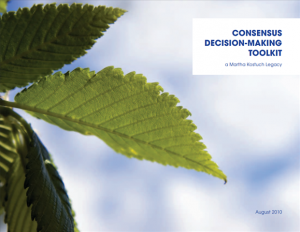
- Resolve from the beginning to work toward common goals and understanding
- Be willing to set aside differences while working on areas where solutions seem possible
- Treat all members of the committee with respect
- Recognize that resource damage of the past and present are often unintentional, and often result from lack of knowledge or information
- Work for consensus, so that everyone will be committed to the actions proposed
- Make field trips and site visits to clarify problems and solutions and increase team cohesion
- Focus on specific, constructive actions that work, not on global environmental problems
- Know that nothing inspires people like success, get a few decisions made as soon as possible
- Have some fun and appreciate the contributions of all involved in a tangible way
Step 2: Identify who should be involved in developing a watershed management plan
The number of people involved in a watershed management plan depends on many factors. A multiple committee format is outlined in the table to the right, but a smaller lake may not require all of these. For detailed information on the roles of each committee, see pages 30-32 of the Workbook.
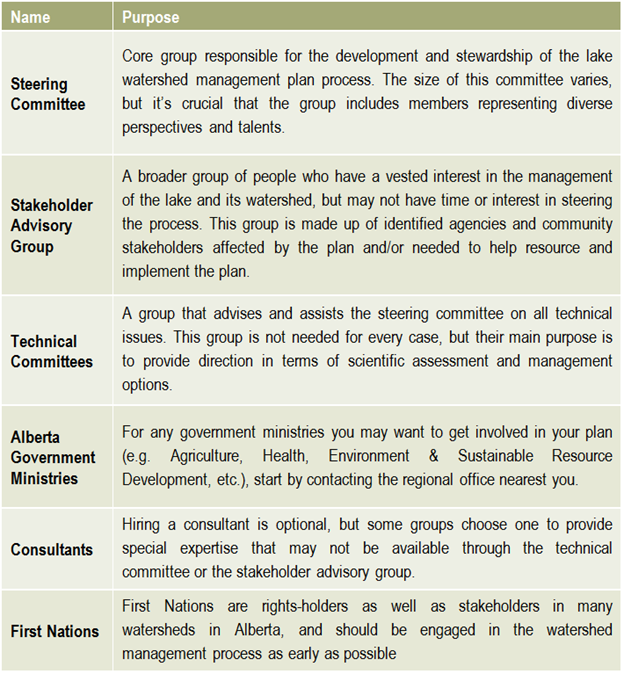 Helpful resources
Helpful resources
To find contact information for Alberta Government Ministry Regional Offices, check www.alberta.ca, or call the information line: (area code) 310-0000
To contact a First Nation, you must first contact their consultation officers/manager. They act as a liaison and communicate ideas from the interested parties to the governance of the Nation. Contact information for a Nation’s consultation officer may be found on the Nation’s website, through their administration office, or via the Government of Alberta consultation contacts.
Step 14: Monitor implementation and outcomes
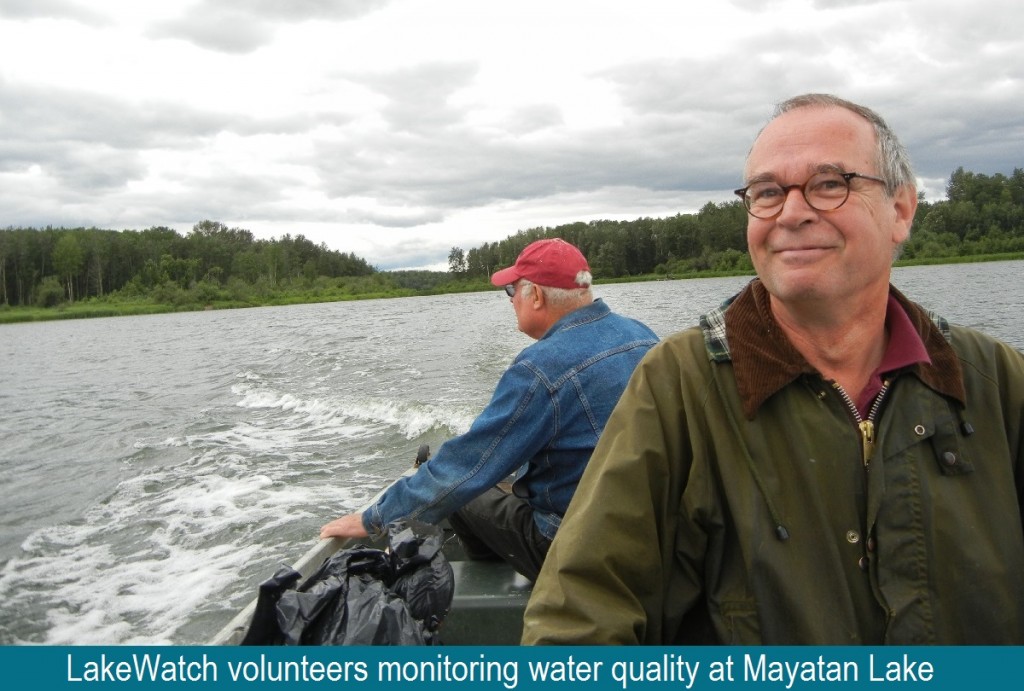 The development of a lake watershed management plan provides the guidance needed to implement activities, but the plan cannot be static. Monitoring the performance of your management actions is essential to understanding whether your goals have been met, and whether further actions are needed. Monitoring and evaluating the implementation and effectiveness of a lake watershed management plan allows assessment of progress towards the goals and objectives of the plan, identification of problems and opportunities, and a collection of critical information required when performing a 5 or 10 year review of the plan.
The development of a lake watershed management plan provides the guidance needed to implement activities, but the plan cannot be static. Monitoring the performance of your management actions is essential to understanding whether your goals have been met, and whether further actions are needed. Monitoring and evaluating the implementation and effectiveness of a lake watershed management plan allows assessment of progress towards the goals and objectives of the plan, identification of problems and opportunities, and a collection of critical information required when performing a 5 or 10 year review of the plan.
Monitoring allows successes to be acknowledged and celebrated, and provides an early opportunity to identify impediments to progress so that adjustments can be made. For example, further management actions, or changes to existing treatments, are sometimes required to restore highly productive lakes.
Step 6: Prepare and confirm support for the terms of reference
The Terms of Reference is the first product of the steering committee, and it states the objectives, process and structure that will guide the development of the lake watershed management plan. The Terms of Reference needs to be approved or endorsed by the group leading the initiative (typically the watershed stewardship group) and members of the stakeholder advisory group. Approval is very important, because it is confirmation of support of the plan and its intended actions within the watershed.
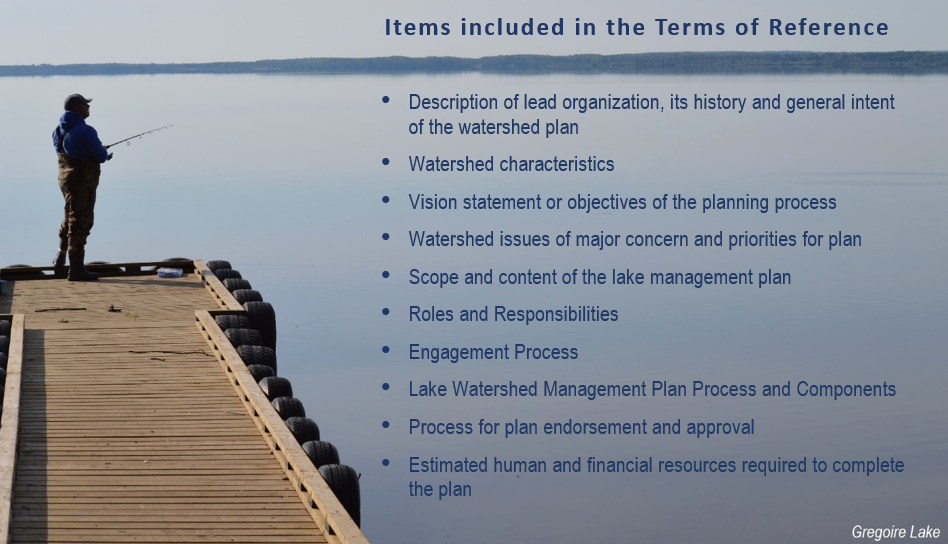
Collaborate
Typically the whole lake watershed management process begins with a group of individuals who are concerned with an aspect of their lake. These issues can be varied, such as water quality concerns or lakeshore development. In Alberta, this is often a Watershed Stewardship Group but the entire watershed management process will require input and involvement from many people in order to be successful. To find a Watershed Stewardship Group near you, check our list or the Alberta Stewardship Network.
Step 2: Identify who should be involved in developing a watershed management plan
Step 3: Determine how participants will work together
Step 4: Establish the structure under which participants will contribute
Adapt
Step 16: Adapt the plan to new information
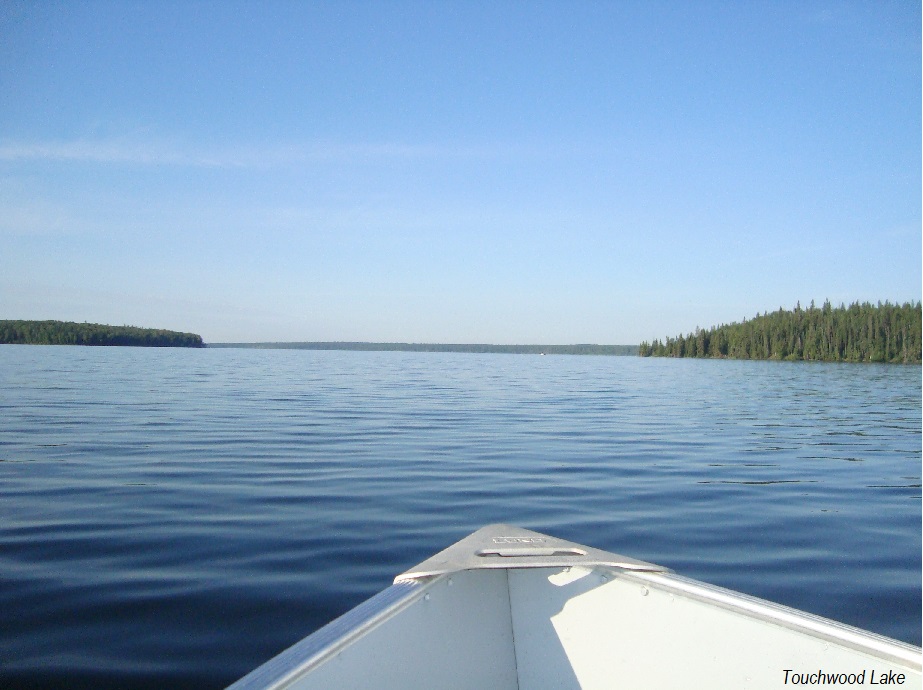 What has the monitoring results of the plan and of the indicators shown? Is there a need to modify the plan? It is important that the lake watershed management plan does not just sit on a shelf. Information gaps should be addressed, action items need to be managed, completed, and evaluated to best address the needs of the lake. Always keep in mind the vision: if the actions taken are not bringing the lake closer to that vision, then the plan needs to be modified. Consider updating both the state of the watershed and the lake watershed management plans at regular intervals to make sure that the actions taken were achieving the desired outcomes and to evaluate what work still needs to be done.
What has the monitoring results of the plan and of the indicators shown? Is there a need to modify the plan? It is important that the lake watershed management plan does not just sit on a shelf. Information gaps should be addressed, action items need to be managed, completed, and evaluated to best address the needs of the lake. Always keep in mind the vision: if the actions taken are not bringing the lake closer to that vision, then the plan needs to be modified. Consider updating both the state of the watershed and the lake watershed management plans at regular intervals to make sure that the actions taken were achieving the desired outcomes and to evaluate what work still needs to be done.
Step 13: Implement the plan
 Once a plan has been approved by all affected sectors and officially endorsed and released by the steering committee, then implementation can begin in full. Action projects can be large and comprehensive, or made smaller by staging projects over time or into modules that can be tackled one at a time. Fundraising is an issue that many community groups may find intimidating, but experience with programs such as the Pine Lake Restoration Program (see Case Studies) suggests that there are excellent funding opportunities in this province for well-thought out projects.
Once a plan has been approved by all affected sectors and officially endorsed and released by the steering committee, then implementation can begin in full. Action projects can be large and comprehensive, or made smaller by staging projects over time or into modules that can be tackled one at a time. Fundraising is an issue that many community groups may find intimidating, but experience with programs such as the Pine Lake Restoration Program (see Case Studies) suggests that there are excellent funding opportunities in this province for well-thought out projects.
Step 11: Build the foundation for successful implementation
Look back on the previous steps to see who is responsible for coordinating and completing each action. Ideally, these assigned actions will be carried away by the different sectors involved (e.g. government, industry, community, ENGOs, members of the watershed stewardship group). If an action belongs to multiple sectors, new working groups may need to be formed.
Watershed management plans form recommendations to governments, and although the plan has no legal authority, the advice it provides may be used to inform decisions made by municipal, provincial, federal, and First Nations governments. A strategy is necessary to ensure that governments are aware of the recommendations and consider them in all of their decisions on an ongoing basis.
Step 10: Draft and confirm support for the plan
Once the outcomes, objectives, indicators and actions have been agreed to by the steering committee, the stakeholder advisory group, and the technical committee, it is time to compile all of the information into a draft document. Also include the next steps, such as how the plan will be implemented, monitored and adapted over time.
The plan recommendations should be clearly communicated to and accepted by stakeholders in the watershed community to be effective. The wider watershed community can be informed and engaged through a variety of ways, like informal consultation, public forums, open houses, traditional media, social media, and websites. The Case Study at Moose Lake describes how the Moose Lake Watershed Society achieved objectives of their plan and got the wider watershed community on board.
A useful resource that outlines the key considerations for communicating your plan to the watershed community is Building Community Support for your Project, by Alberta Agriculture.
Step 4: Establish the structure under which participants will contribute
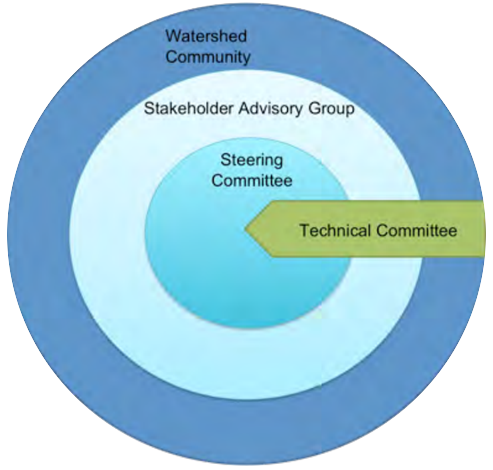 This graphic describes how the various committees and groups will work and interact together. The circle size depicts the approximate number of people involved, and the circles overlapping indicates that some individuals may reside in all of the circles and participate in multiple committees as part of the planning process. The technical committee is shown as an arrow, indicating that it is independent and has relatively few people, and yet it interacts with all of the groups. This graphic may look different depending on the lake and the people involved, and a detailed structure should be agreed upon and described in the plan’s Terms of Reference (Step 6).
This graphic describes how the various committees and groups will work and interact together. The circle size depicts the approximate number of people involved, and the circles overlapping indicates that some individuals may reside in all of the circles and participate in multiple committees as part of the planning process. The technical committee is shown as an arrow, indicating that it is independent and has relatively few people, and yet it interacts with all of the groups. This graphic may look different depending on the lake and the people involved, and a detailed structure should be agreed upon and described in the plan’s Terms of Reference (Step 6).
Monitor & Report
The next two steps are important for understanding the effectiveness of the plan and for keeping a record of what may work and what may not. Regular monitoring and reporting as the plan is implemented allows successes and potential impediments to be recognized, resulting in celebrations of achievements, or adjustments to be made.
Plan
Data collected and the State of the Watershed (SoW) reports written thus far are critical to understand the severity of the lake’s problems and figure out what has caused them, but the lake watershed management plan, developed collaboratively, is now the place to detail the strategy to address the issues that stakeholders want to focus on in the lake’s watershed. A sample of a Table of Contents for a Watershed Management Plan is pictured here. (from page 36 in the guide).
Step 5: Identify priorities and the scope and scale of planning activities
Step 6: Prepare and confirm support for the terms of reference
Step 7: Develop a communications and engagement strategy
Step 8: Identify outcomes, objectives, and indicators
Step 9: Develop, evaluate and select preferred management actions
Implement
Once your group has developed a detailed action plan you will need to take specific steps to turn the recommendations into reality.
Step 11: Build the foundation for successful implementation
Adapt



